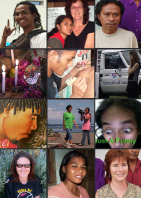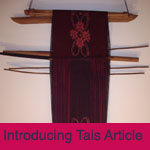Introducing the Tais
I first saw a tais, the hand-woven textile of Timor, at the launch of the Friends of Suai in March 2000 in the gardens next to Luna Park in St Kilda. The tais was displayed in an exhibition with pottery, paintings, wood carvings and other craft objects. I understood the impact of seeing these objects much later when I realised how different Timorese culture is to Indonesian culture. The next time I saw tais was in an exhibition mounted by Sara Niner for the Alola Foundation, at Gasworks in Port Phillip for the Melbourne Festival of Arts in October 2000.
Since 2000 Sara has been touring Timor researching and buying tais for the Alola Foundation collection she has learned much about it. Since information about the tais is difficult to find I will use her words to describe a little of what the tais is, its meaning to the men and women of East Timor and a little about its role in Timorese culture. Sara wrote this for the Forum she convened in September 2008 titled: ‘Exploring Meanings, Makers and Markets of Tais, the Hand-woven Textiles of East Timor‘. The Forum was accompanied by an extensive exhibition in the St Kilda Town Hall Gallery in Port Phillip and there is a comprehensive slideshow here. Don’t miss the response to this article by Cova Lima expatriate Balthasar Kehi in the comments field
“Hand-woven textiles called tais (tie-iss) are used for cultural and ritual exchange, worn as costumes and, in recent times, have been offered for sale. Indigenous society in East Timor is ordered by kinship and alliances maintained through marriage and exchange. Textiles remain a valueable expression of local knowledge and culture. They are physical embodiment of femaleness and, as sacred Lulik objects, possess special powers. In Timor designs and techniques have been handed down matrilineal lines recording a woven narration of the culture, lore, paradigms and stories of Timor’s history. By producing, exchanging and owning sacred hand-woven cloth, women can maintain a certain strength and power within this clan-based society. Master weavers hold an esteemed social position and are often related to royal Liurai lineage”.
“The weaving, wearing and use of the textiles are essential to the Timorse sense of being and was a way of asserting their different identity during Indonesian occupation and for some women it consituted a form of passive resistance. Women also traded their products for goods the resistance needed and women are proud of their efforts. Today national recognition of the cultural importance of weaving is expressed by the wearing of tais by national leaders, their display in the national parliament, on national stamps and their use in government campaigns. Textiles play a role in construction of a new national identity.
The hand-woven textiles produced by East Timorese women are a vital part of their culture, especially after decades of destructive conflict. Weaving has also helped women overcome the tragedies of the past by providing a familiar and meaningful structure around which a community renews itself. Communities of women often come together to weave. It provides a sense of continuity with the past”.
If you have an interest in textiles, weaving or tais, you can use the RSS Feed to ensure you receive an email when ever I post and tag an article or a story that refers to the tais.
You can follow any responses to this entry through the RSS 2.0 feed. Both comments and pings are currently closed.











October 30th, 2008 at 4:57 pm
Comment sent by Balthasar Kehi
I would like to add several comments to the many good things that Dr Sarah Niner has beautifully written about Tais and Tais Weaving in East Timor as quoted above by Jen Hughes.
The practice of weaving tais has existed not only East Timor but also in West Timor, in the whole island of Timor known and respected mythically as Lafaek (Crocodile) or Nai Bei (Great Great-Grand Mother). Weaving was practiced long before the Crocodile was brutally cut into two pieces right across its belly by two Western colonial masters, the Portuguese and the Dutch, in 1859 and finally in 1915, before those colonizers set foot on the Island of Timor and robbed us of our property.
Often one finds in designs of tais the picture of the whole crocodile. This integrated crocodile symbolizes the undivided Timor. It is a symbol of resistance against the politically imposed division of the island and its people by the two Western colonial powers. It is also perhaps an indication of an unconscious collective nostalgia of one Timor, without a border. It is a reminder to the Timorese in both West Timor and East Timor that they are all Timorese, the sons and daughters of the same mythical ancestor, the Crocodile, and that the imposed division, which has pained them so much, is against their will and integrity as a people.
The crocodile symbol also expresses a dream for the reunification of the two parts of the Crocodile – of her sons and daughters living in those two parts that are separated by the colonial imposed border, the legacy of the Portuguese and Dutch rivalry over the possession of the island of Timor.
The cultural practise of tais weaving also has existed in the islands of Sawu and Rote close to Kupang, and in the islands of Flores and Sumba, that together with West Timor, (plus the islands of Solor, Adonara, Lembata, Alor and Pantar) form the Province of NTT (Nusa Tenggara Timur).
The practice of weaving tais continued to exist during the Portuguese, Dutch, Japanese and Indonesian occupation of Timor. During the occupation of East Timor after 1975, the Indonesians did not destroy or ban the cultural practice of weaving tais. Of course many people could not grow cotton and many women could not weave tais because of the war.
The Indonesian government, through its Department of Education and Culture, at the national, provincial and district levels, promoted local culture as kebudayaan asli daerah – indigenous local culture. Indigenous culture included things such as traditional dances, songs, weaving, dress, crafts etc, throughout all Provinces in Indonesia from Sabang to Merauke, including the Province of East Timor.
Tais weaving was promoted by the Indonesian government as part of the promotion of local culture of the Province of East Timor. The introduction of synthetic threads (called benang toko) that undermine the threads from the locally grown cotton took place not only in East Timor but also in West Timor and in others islands mentioned above as part of the so called “development” and “modernity” brought by Suharto’s regime.
The process of making tais also involves men. Although it is women who spin the cotton and do the weaving, it is men who grow cotton, make and carve the looms for weaving.
In addition to functions of tais as Dr Niner mentioned above, tais have other important functions, such as for covering or wrapping the dead body. The more important and loving a person was the more beautiful are the tais that are used to cover his/her body for the funeral. Every family traditionally keeps several beautiful tais for themselves in case there is a death in the family. Young women make several tais diak for their old parents and/or grandparents as a preparation for their deaths as well as for their old uncles and aunts. Older women made beautiful tais and kept them for themselves or their husbands to be used for covering their dead bodies.
Tais is also used as part of bride price and it is also used as means of reconciliation. In some part of Timor there is no reconciliation without tais. The guilty party would offer tais to the other party and to the elders of the community as peace-makers after he/she humbly acknowledges his/her wrong doings in the community and asked for forgiveness.
There are three different forms of tais, that is, tais feto (female tais), tais mane (male tais) and tais sakat or selendang (scarf) worn by both men and women.
Tais, like painting, is a form of literature that has a narrative function. Making tais is an activity of aesthetic creativity. Tais is the result of that activity. The making of tais is also an act of resisting and defeating the boredom and meaninglessness of life. It is an act of affirming one’s meaning of life and identity individually and collectively. Although some patterns (futus) tais in East Timor may express the resistance against the Indonesian occupation, making tais is not necessarily a symbol of resistance against the occupation as its making was encouraged and promoted by the Indonesian government and military, as it was also, in West Timor and other islands of the Province of NTT (Nusa Tenggara Timur).
There are also sacred tais (tais lulik), that is, beautiful tais which are offered to ancestors and to God called Maromak (the Enlightening Being) through a religious ceremony involving prayers and blessing as well as the offering of cooked rice and the best parts of meats from chicken, pigs, goats, buffaloes specially slaughtered for that ceremony led by the respected elder of the community. Thie tais lulik are usually kept in uma lulik (sacred houses) of the community along with other sacred objects or relics.
Balthasar Kehi
November 7th, 2008 at 3:50 pm
[…] Traditional Culture East Timor | 2 Outubro 2008 Jen Solok tuir Internet Istoria kona ba Soru Tais English Isin primeiru hau hare tais maka ema Feto Timor oan sira soru ba loron ida iha fulan Marsu 2000 […]
December 2nd, 2008 at 4:12 pm
thank you, I am learning
Marg
January 28th, 2010 at 3:30 pm
Thanks for posting this, lifted my day.